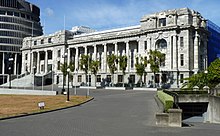This article needs additional citations for verification. (April 2015) |
| 41st Parliament of New Zealand | |||||
|---|---|---|---|---|---|
| |||||
 | |||||
| Overview | |||||
| Legislative body | New Zealand Parliament | ||||
| Term | 15 August 1984 – 29 July 1987 | ||||
| Election | 1984 New Zealand general election | ||||
| Government | Fourth Labour Government | ||||
| House of Representatives | |||||
 | |||||
| Members | 95 | ||||
| Speaker of the House | Gerard Wall from 28 May 1985 — Basil Arthur until 1 May 1985 † | ||||
| Leader of the House | Geoffrey Palmer | ||||
| Prime Minister | David Lange | ||||
| Leader of the Opposition | Jim Bolger — Jim McLay until 26 March 1986 — Robert Muldoon until 29 November 1984 | ||||
| Sovereign | |||||
| Monarch | Elizabeth II | ||||
| Governor-General | Paul Reeves — David Beattie until 22 November 1985 | ||||
| Sessions | |||||
| |||||
The 41st New Zealand Parliament was a term of the Parliament of New Zealand. Its composition was determined by the 1984 elections, and it sat until the 1987 elections.
The 41st Parliament was the first term of the fourth Labour Party government. It marked the end of three terms of National Party administration under Robert Muldoon. David Lange become Prime Minister and Roger Douglas became Minister of Finance — the economic reforms undertaken by Douglas, nicknamed Rogernomics, would prove to be a defining feature of the fourth Labour government, and were deeply unpopular with Labour's traditional support base. The National Party, now in opposition, experienced a number of leadership disputes, replacing Muldoon first with Jim McLay and then with Jim Bolger.
The 41st Parliament consisted of ninety-five representatives, the highest number since the 10th Parliament (elected in 1887). All of these representatives were chosen by single-member geographical electorates, including four Māori electorates.